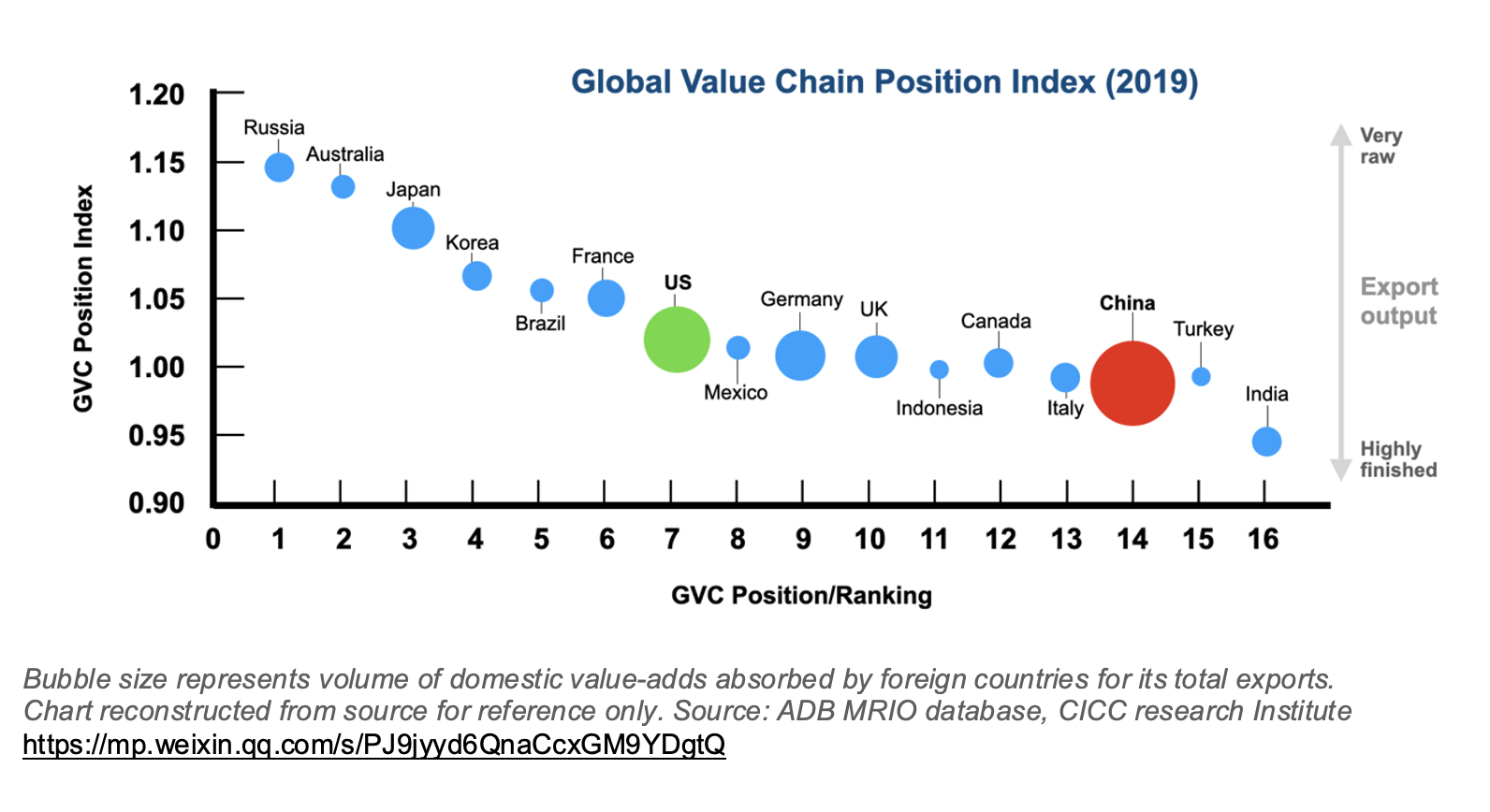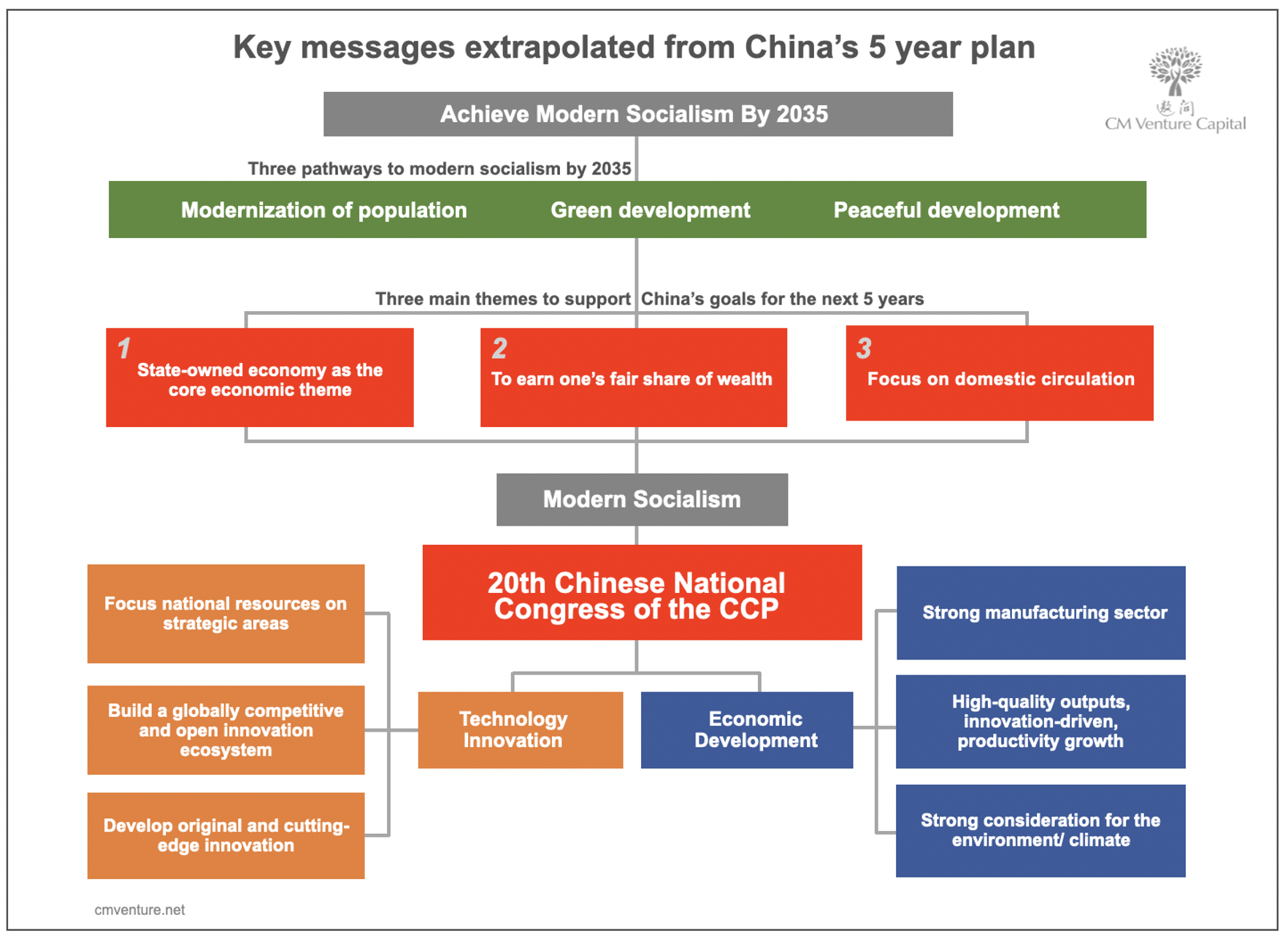China needs to add more innovation and value to the goods it produces to grow its economy. The recent Chinese National Congress gave a clear indication of supporting this.

With the conclusion of the 20th Chinese National Congress of the CCP in October 2022, we’re taking a dive into interpreting China’s latest economic objectives and goals. At the same time, we’ve put them into the wider context of China’s relation to the global economy.
One of the indicators we examined is China’s ranking in the Global Value Chain (GVC). GVCs are part and parcel of today’s finished goods, and is powerful driver of productivity growth, job creation and increased living standards.
The GVC Position Index assesses a nation’s upstream/downstream positions on the value chain. Russia exports mostly minerals, ie. oil/gas, so it is upstream. Japan and US are upstream because they export research and development, intellectual property and half-finished goods. China is downstream because it exports mostly goods in a highly-finished state.
What’s more interesting is the bubble size, which represents the volume of domestic value-adds absorbed for its total exports. The China and US are the two biggest bubbles, but the exports as percentage of their GDPs are ~ 10% for the US vs ~ 20% for China. Furthermore, the US exports mostly IP and high-value components, while China exports more assembled goods with less value-add.
As it stands, for China to grow its bubble, it needs to add more value to its end products through innovation and making higher value goods. Otherwise, it’s unable to do much more, as China does not have raw material advantages. We also see that the US can grow its bubble by moving manufacturing back onshore, delivering more finished goods.

The GVC Position Index is deeply related to the latest Chinese National Congress. With a newly elected Politburo Standing Committee, General Secretary Xi Jinping gave a speech which outlined key goals for the country for the next 5 years.
The cornerstone of his speech undeniably focused on the pursuit of innovation. It was declared that China should “use technology as a primary productive force and innovation as a primary engine.”
This was anchored by 3 points: (1) focus national resources on strategic areas (2) build a globally competitive and open innovation ecosystem, and (3) develop original and cutting-edge innovation.

Other highlights drawn out from the week-long session include China’s aims to achieve modern socialism by 2035. This is done though modernisation of its population, achieving common prosperity through a reduction of wealth gaps. Prosperity is defined to include material and spiritual wealth. Two other points also stand out: achieving harmony with nature through green development, and peaceful development.
The Chinese economy emphasises on high-quality development through:
- A strong manufacturing sector (not just size, but also strength)
- High quality outputs, innovation-driven, productivity growth
- Strong consideration for the environment/climate
China is abandoning its earlier hard commitments to carbon-neutrality in 2060.
The key message on environmental responsibility is interesting. Xi’s speech suggested to “先立后破” (xian li hou po – meaning to ‘rise above and break though’), but omitted the mention of specific years for carbon-peaking and carbon-neutrality goals. Our take on this is that China wants to establish sufficient clean energy resources before shutting down traditional energy sources. It is abandoning its earlier hard commitments to carbon-peaking in 2030 and carbon-neutrality in 2060, for a more pragmatic and flexible path.
Xi has also set three main themes to support China’s goals for the next half decade.
3 main themes to support Chinese growth
- Theme 1: 公有制为主体 (gong you zhi wei zhu ti): The state-owned economy will be the core economic theme.
- Theme 2: 按劳分配为主体 (an lao fen pei wei zhu ti): To earn one’s fair share of wealth through labor, not just wealth creation from capitalism.
- Theme 3: 国内大循环为主体 (guo nei da xun huan wei zhu ti): Focus on domestic circulation, with higher-quality and reliable goods & services for its domestic population.
An unusual standout keyword from his speech was “斗争 (dou zheng)”, targeted at foreign influences. This alludes to how China should stand up against opposition with confidence. Which means that China is willing to face confrontation with the west over what it considers as its core interests and values.
There has never been more clear, strong and firm policy supports for Chinese hard-tech.
Overall, we believe that the 20th CCP congress provided clarity on what matters to China’s leadership. There has never been more clear, strong and firm policy supports for Chinese hard-tech, innovation, and manufacturing upgrades – the golden time is here and now.
Written and researched by CM Venture Capital’s investment team, a China-headquartered investment company which partners with a number of multinationals to help them invest in cutting-edge hardtech.








